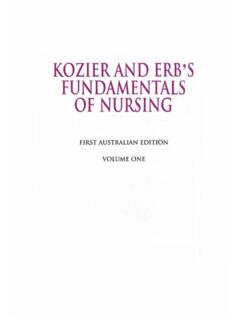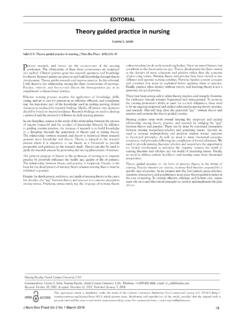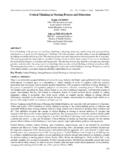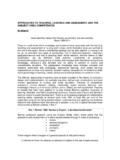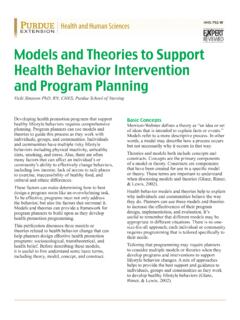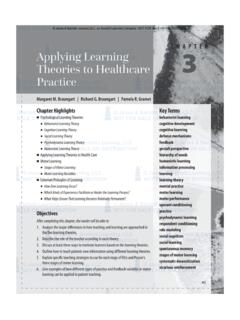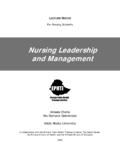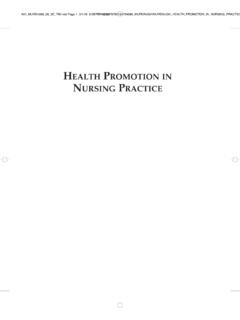Transcription of Theories of Stress and Its Relationship to Health
1 22 Conceptualizations of Stress and the Stress response have varied in form and context throughout the centuries. Florence Nightingale wrote in Notes on Nursing (1860/1969),In watching disease, both in private houses and in public hospitals, the thing which strikes the experienced observer most forcibly is this, that the symptoms or the sufferings generally considered to be inevitable and incidental to the disease are very often not symptoms of disease at all, but of something quite different of the want of fresh air, or of light, or of warmth, or of quiet, or of cleanliness, or of punctuality and care in the administration of diet, of each or of all of these.
2 (p. 8)Nightingale believed that all patients were experiencing some Stress (as it was later to be called) regardless of their illness. She wrote to nursing, If you knew how unreasonably sick people suffer from reasonable causes of distress, you would take more pains about these things (p. 104). Nursing s challenge is to facilitate the reparative process (p. 9). More than 70 years later, Hans Selye (1936), a young medical stu-dent at the University of Prague, wrote,Whether a man suffers from a loss of blood, an infectious disease, or advanced cancer, he loses his appetite, his muscle strength, and his ambition to accomplish anything; usually the patient also loses weight and even his facial expression betrays that he is ill.
3 (p. 19)He labeled this phenomenon the syndrome of just being sick and pursued the catalysts and processes of this syndrome in the laboratory and in his medical practice for more than 50 years. He described it as Stress -response theory and systematically examined its Relationship with Health . Other researchers of the Stress -response phenomenon include Mason (1971), McEwen (1998), and McEwen and Wingfield (2003). This chapter examines, in depth, the development of Stress -response theory and the wealth of research, theory development, and clinical implications that have been derived from the TheorySelye (1976a) initially proposed a triadic model as the basis for the Stress -response pattern.
4 The ele-ments included adrenal cortex hypertrophy, thy-micolymphatic ( , the thymus, the lymph nodes, and the spleen) atrophy, and gastrointesti-nal ulcers. These three, he reasoned, were closely interdependent; they seemed to accompany most illnesses and were provoked no matter what the stimulus or illness. Selye could evoke the response in laboratory rats with agents such as formalin, enzymes, hormones, heat, and cold, and he 2 Theories of Stress and Its Relationship to HealthVirginia Hill Rice CHAPTER 2. Theories of Stress and Its Relationship to Health 23observed it in patients with such diverse Health problems as infections, cancer, and heart disease.
5 He noted that the syndrome probably represented an expression of a generalized call to arms of the body s defensive forces in reaction to excessive demands or provocative stimuli. Selye (1936) called this nonspecific response to damage of any kind Stress . Later, he used the term stressor to des-ignate the stimulus that provoked the Stress response (Selye, 1976b). To derive a conceptual-ization of Stress , Selye (1974) chose to delineate what it was not. He wrote that Stress is not: 1. simply nervous tension; it can occur in organisms without nervous systems or in anesthetized or unconscious patients.
6 2. an emergency discharge of hormones from the adrenal medulla; although catecholamines are a part of the Stress reaction, they are not the only hormones activated, and they play no role in generalized inflammatory diseases or local Stress reactions. 3. everything that causes a secretion of the adrenal cortex ( , corticoids); adrenocorticotropic hormone (ACTH) can stimulate the release of corticoids without producing a Stress response. 4. always the nonspecific result of damage; normal activities, such as tennis or a passionate kiss, can produce a Stress response without conspicuous damage.
7 5. the same as a deviation from homeostasis (Cannon, 1932), the body s steady state: Reactions to loud noises, blinking of the eye, or contracting a muscle may cause deviations from the resting state without evidence of a generalized Stress reaction. 6. anything that causes an alarm reaction: It is the stressor that is the stimulus and not the Stress itself. 7. identical with the alarm reaction: These reactions are characterized by certain end-organ changes caused by Stress and, hence, cannot be Stress . 8. a nonspecific reaction: The pattern of the Stress response is specific, although its cause and effects may vary.
8 9. necessarily bad: The Stress of success, challenge, and creativity is positive, whereas that of failure, anxiety, and infection can be negative. 10. to be avoided: Stress cannot be avoided. It is ubiquitous; it is an essential ingredient of viewed Stress as the common denominator of all adaptive reactions in the body and com-plete freedom from Stress as death (Selye, 1974).In his first publication on Stress in Nature in 1936, Selye defined Stress as the nonspecific response of the body to any demand made on it (p. 32). Following criticisms for being too vague, confusing, and ambiguous, he offered the fol-lowing operational definition: Stress is a state manifested by a specific syndrome which consists of all the nonspecifically induced changes within the biological system (Selye, 1976b, p.)
9 64). He proposed that such changes were measurable and occur at both the system and the local level. The entire Stress process at the system level, including the threat and the individual s reac-tion to it, he called the general adaptation syn-drome (GAS). (See Figure ) The regional response ( , localized inflammation where microbes have entered the body) he termed the local adaptation syndrome (LAS). The GAS and LAS are seen as closely coordinated, with the GAS acting as backup (Selye, 1976a). The GAS is described in detail in the following Adaptation SyndromeSelye (1950, 1956) noted that throughout history aspects of Stress and the Stress phenom-enon floated aimlessly like loose logs on the sea, periodically rising and falling in waves of popularity and disgrace.
10 He attempted to bind together these loose logs of observable facts with solid cables (workable Theories ) and secure them with a resulting raft (GAS) by mooring it to generally accepted classical med-icine in space and time. In space, the three fixed points were the triad of adrenal, thymicolym-phatic, and intestinal changes. In time, three distinct phases were identified as the alarm reaction, resistance stage, and exhaustion stage. (See Figure ) Bringing together these points of space and time, he reasoned, permitted Stress to be less ethereal and more amenable to scientific (1976b) labeled this process general because it was produced only by agents which have a general effect upon large portions of the body, adaptive because it stimulated defense 24 PART II.










